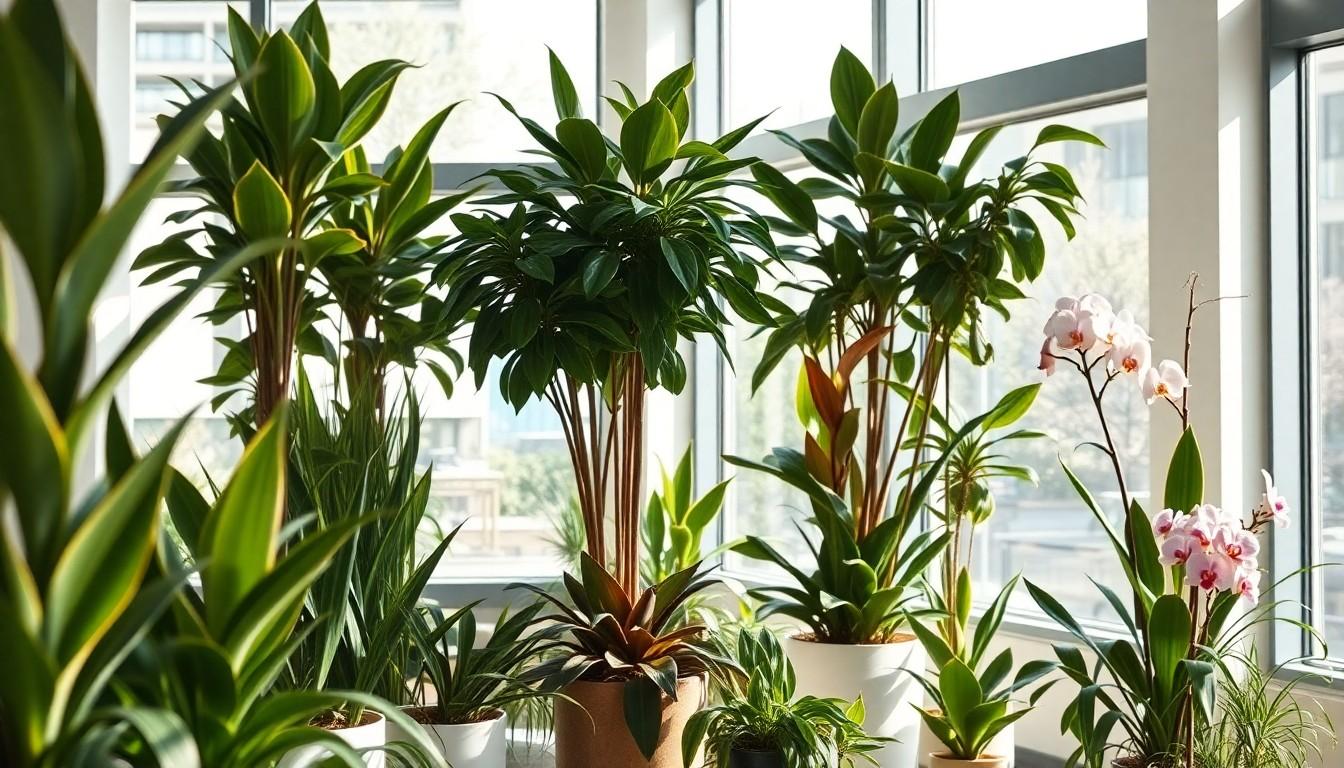In the hustle and bustle of office life, it’s easy to forget that a little greenery can do wonders for productivity and mood. Enter indoor office plants—the unsung heroes of the workplace. These leafy companions not only brighten up dreary cubicles but also help reduce stress and boost creativity. Who knew a fern could be your new best coworker?
Benefits Of Indoor Office Plants
Indoor office plants offer numerous advantages, contributing significantly to a healthier and more productive work environment.
Improved Air Quality
Improved air quality stands out as a primary benefit of indoor office plants. They filter harmful toxins, such as formaldehyde and benzene, promoting cleaner air. Research shows that specific plants can reduce volatile organic compounds by up to 60%. Cleaner air supports better respiratory health, allowing employees to work more comfortably. Additionally, plants release oxygen, enhancing overall air quality. Incorporating plants not only beautifies the space but also helps maintain a healthier office atmosphere.
Enhanced Productivity
Enhanced productivity arises as another key advantage of having indoor plants. Studies indicate that workplaces with greenery see a productivity increase of around 15%. Working in an environment enriched with plants can lead to better concentration and decreased absenteeism. Employees report higher levels of satisfaction and motivation when surrounded by nature. Furthermore, improved air quality and reduced stress levels also contribute to increased work output. Incorporating indoor plants in the office creates a more engaging and stimulating environment.
Psychological Well-Being
Psychological well-being is influenced positively by the presence of indoor office plants. Studies reveal that plants can decrease stress levels and boost mood. Employees often feel more relaxed and less anxious when surrounded by greenery. Exposure to plants enhances creativity, encouraging innovative thinking. Additionally, views of nature or greenery correlate with improved mental health. Integrating indoor plants into the workspace fosters a more supportive and uplifting atmosphere for everyone.
Types Of Indoor Office Plants

Indoor office plants offer a variety of choices to enhance any workspace. Selecting the right types can significantly improve both the environment and employee well-being.
Low-Maintenance Options
Succulents fit seamlessly into busy office routines due to their minimal care requirements. Snake plants tolerate low light and infrequent watering, making them ideal for beginners. ZZ plants require little attention, thriving on neglect, while pothos are forgiving and can adapt to various lighting conditions. These plants support a thriving atmosphere without demanding much time from staff.
Air-Purifying Plants
Spider plants effectively filter indoor pollutants, contributing to cleaner air. Peace lilies excel at removing harmful substances, promoting a healthier workspace. Bamboo palms not only elevate aesthetics but also improve air quality significantly. Incorporating these air-purifying options ensures a fresher environment that enhances respiratory health and overall productivity.
Aesthetic Choices
Orchids introduce elegance and color to office spaces, creating an inviting atmosphere. Rubber plants bring a modern touch with their glossy leaves, adding visual interest. Fiddle leaf figs stand out with their large foliage and striking design, making them a popular choice. Selecting these aesthetic plants transforms the office landscape into a visually appealing and inspiring environment, encouraging creativity and boosting morale.
Best Practices For Caring For Indoor Office Plants
Caring for indoor office plants enhances their benefits, ensuring they thrive in the workspace. Proper maintenance involves understanding watering needs, light preferences, and soil requirements.
Watering Techniques
Watering methods vary among plant types. Most indoor plants prefer slightly dry soil, preventing overwatering. Regular monitoring is essential; check soil moisture weekly. If the top inch feels dry, it’s time to water. Use room temperature water to avoid shocking the roots. Additionally, plants like succulents require less frequent watering. Adjust frequency during seasonal changes, as light levels and humidity affect water needs.
Light Requirements
Light influences plant growth, so understanding each plant’s needs is crucial. Low-light plants, such as snake plants and ZZ plants, thrive in indirect sunlight. Alternatively, bright light plants, like peace lilies, require a sunny window. Position plants based on their light preferences; observe for signs of distress. Dark leaves often signal insufficient light, while scorched leaves indicate too much sun. Rotate plants every few weeks to encourage even growth.
Soil and Fertilization
Soil choice impacts plant health significantly. Well-draining soil suits most indoor plants, preventing root rot. Consider using potting mixes that contain perlite or peat moss. Fertilization typically varies between the growing and dormant seasons. During spring and summer, applying a balanced fertilizer every four to six weeks promotes growth. Reduce or eliminate fertilization in fall and winter when plants enter dormancy. Regular repotting every couple of years rejuvenates soil and encourages healthy root systems.
Choosing The Right Indoor Office Plants For Your Space
Selecting the right indoor office plants significantly enhances the work environment. Consider key factors to ensure optimal growth and compatibility with your space.
Factors To Consider
Evaluate light conditions before choosing plants. Natural light availability varies across offices, influencing plant selection. Assess temperature range within the workspace, as most plants thrive in temperatures between 65°F and 75°F. Humidity levels also affect plant health; higher humidity benefits tropical plants while drier air suits succulents. Factor in the time and effort available for maintenance, as low-maintenance plants like snake plants or pothos suit busy schedules. Finally, consider the overall office aesthetic, ensuring selected greenery complements existing decor and promotes a harmonious atmosphere.
Popular Species For Different Environments
For low-light environments, opt for snake plants and ZZ plants as they flourish without direct sunlight. Peace lilies adapt well to varying light conditions and improve air quality effectively. If bright light is accessible, choices like fiddle leaf figs and rubber plants make a bold statement while thriving. Cubicles with limited space benefit from compact succulents and pothos, both stylish and easy to care for. Each plant species brings unique characteristics, enhancing the office’s overall appeal and benefits for employees.
Conclusion
Integrating indoor office plants into the workspace can transform the atmosphere and enhance employee well-being. These green companions not only purify the air but also foster creativity and reduce stress, making them essential for any office environment. With a variety of low-maintenance options available, even the busiest professionals can enjoy the benefits of greenery without added pressure.
By choosing the right plants for specific conditions and ensuring proper care, workplaces can create a vibrant and inviting space. The positive impact on productivity and morale is undeniable, proving that a little greenery goes a long way in cultivating a healthier and more inspiring work environment.

